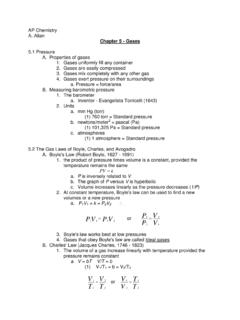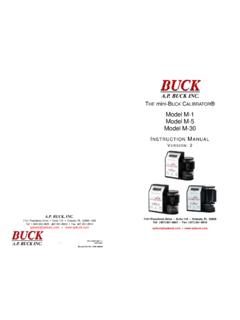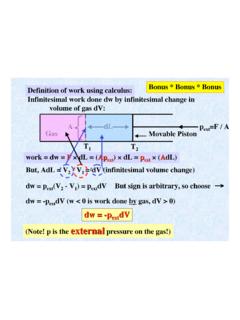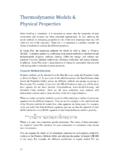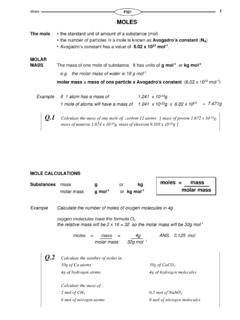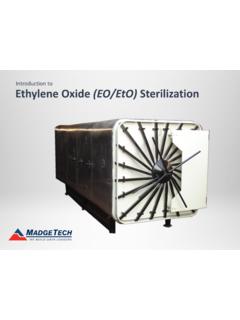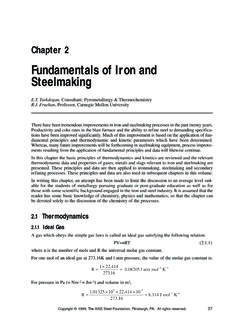Transcription of Ideal Gas and Real Gases - Eötvös Loránd University
1 Gas and real GasesLectures in Physical Chemistry 1 Tam s Tur nyiInstitute of Chemistry, ELTES tate propertiesstate property:determines the macroscopic state of a physical systemstate properties of single component Gases : amount of matter, pressure, volume, temperaturen, p, V, Tamount of matterdenoted bynname of the unit: mole(denoted bymol ) 1 mol matter containsNA= 6,022 1023particles,Avogadro constantpressuredefinitionp=F/A, (forceFacting perpendicularly on areaA)SI unit pascal (denoted by: Pa): 1 Pa = 1 N m-21 bar= 105Pa; 1 atm=760 Hgmm=760 torr=101325 properties 2volumedenoted byV, SI unit: m3volume of one mole matterVmmolar volumestate properties of single component Gases :n, p, V, Ttemperaturecharacterizes the thermal state of a bodymany features of a matter depend ontheir thermal of a liquid, colour of a metal3 Temperature scales 1: FahrenheitFahrenheit scale (1709).
2 0 F (-17,77 C) the coldest temperature measuredin the winter of 1709100 F (37,77 C) temperature measured in therectum of Fahrenheit s cowbetween these temperatures the scale is linear(measured by an alcohol thermometer)lower and upper reference temperaturearbitrarylower and upper reference temperaturenot reproduciblean original thermometer was needed for making further copiesProblem:Fahrenheit personally had to make copiesfrom his original thermometerDaniel Gabriel Fahrenheit (1686-1736) physicists, instrument scales 2: Celsiuscentigrade scaleorCelsius scale (1742; 1750):0 C temperature of melting ice in 1 atm air100 C temperature of boiling water in 1 atm airbetween these temperatures the scale is linear(measured by an alcohol thermometer)Problem: if other liquids are used ( ), then different middle temperatures are measuredAnders Celsius (1701-1744) Swedish astronomer5lower and upper reference temperaturearbitrarylower and upper reference temperaturereproducibleanyone can make a new centigrade scale thermometerTemperature scales 3: KelvinKelvin scaleorabsolut temperature scale (1848).
3 0 K (-273,15 C) extrapolated zero volume of an Ideal gas273,16 K (0,01 C) temperature of the triple point of waterbetween these temperatures the scale is linear(measured by a gas thermometer)Problem: Ideal gas does not existLord Kelvinborn as William Thomson(1824-1907) Scottish physicist6lower and upper reference temperaturesphysically well basedlower and upper reference temperaturesreproduciblethis is the real ( thermodynamic ) temperature Law of ThermodynamicsWhat does it mean:Using thermometerB, the temperature of body A, then the temperature of body Cis the thermometer shows the same reading, then the temperature of bodiesAand Care equal.
4 Ifsubstance A is in thermal equilibrium with substance B andsubstance B is in thermal equilibrium with substance Cthensubstance A is in thermal equilibrium with : the condition is thermal equilibrium, notthermodynamic equilibrium !7 Equation of state of the Ideal gas: Ideal gas lawp V= n R T orp Vm= R Tppressure (Pa)Vvolume (m3)namount of matter (mol)Ttemperature (K)Rgas constantR= J K-1mol-1 Regnault constant DEF: Ideal gas or perfect gas: imagined gas that obeys exactlythe perfect gas equation of state. at high temperature and not very high pressurethe equation of state of the Ideal gas is a good Victor Regnault(1810-1878)French names on the Eiffel s Law mole fraction njof component jis the ratio of the corresponding partial pressure and of the total pressure.
5 DEFFor mixtures of Gases , partial pressure of a component gas is the pressure exerted by this gas occupying the same volume alone. Dalton s Law: the pressure of a mixture of perfect gasses is equal to the sum of the partial pressures. ()RTnnnpVK+++=K21 KKpppVRTnVRTnVRTnp+++=+++=KK2121ppRTpVRT V pnnnnxjjKjj==++=//21 KJohn Dalton (1766-1844)English gasescompression factor diagram of nitrogen gasthe significant effects are above 10 bar!DEFI mperfection of real Gases can be characterized by thecompression factorZZpVRT=m/0,900,951,001,051,101,151 ,201,251,30050100150200250300350400p/bar Z=pVm/RTabcdefa: 233K (-40 C)b: 255 K (-18 C)c: 273 K ( 0 C) d: 327,2 K (54,05 C)e: 478 K (205 C)11 Compression diagramshape of the Z(p) curve:curvature downwards: attracting forces between the moleculesgoing up: repelling forces / own volume of the moleculesDEFC ompression diagram: Z pcurveplease note:- at (almost) zero pressureZ = 1- for an Ideal gasZ= 1 always- real gas, high pressure.
6 HighZ- at the Boyle temperature: Zstarts horizontally- below the Boyle temperature: Zstarts below 1- above the Boyle temperature: Zis always above 10,900,951,001,051,101,151,201,251,30050 100150200250300350400p/barZ=pVm/RTabcdef DEF:Boyle temperature:Z(p) starts horizontally at this temperaturesignificance:at the Boyle temperature the real Gases behave (almost) like theideal Gases if the pressure is not very high( p< 30 bar)Boyle temperature for N2: 54,05 C ( air behaves like an Ideal gas at 298K) of state of real gasesplease note:using the virial equation of state, theZ(p) curveis approximated with a polynomialthe constant term is 1, because ifp=0 thenZ=1polynomial of any order can be used any accuracy can be achievedB , C.
7 Temperature dependentempirical constantsthe favourite of chemical engineers due to its high accuracyTVvirial equation of stateK+ + +==21/pCpBRTpVZmRobert Boyle(1627-1691)English chemist13the idea of van der Waals:let us take the equation of state of Ideal Gases :p V = n R Tppressure is corrected with a term that takes into account the attractive forcesbetween the molecules. This term includes empirical (the volume of the box) is corrected by the own volume of the volume is bfor 1 mole, nbfornmoles of moleculesaand bareempirical constantsand do not depend on temperatureThis equation of state is simple, but not very accurate (say, error is below 1%).
8 Van der Waals equation of stateJohannes Diderik van der Waals (1837-1923) Dutch physicist()nRTnbVVanp= +22 Equations of state of real Gases of Ideal gaseslower temperature:the isotherm is getting closer to the axes, but keepingthe hyperbolic shape(sincep V= constant always)DEFisotherms of Gases :p(V)curve at constant temperature(axisx: volume, axisy: pressure)pV15T1T2 TcppcCVcVT3T4 Isotherms of real gaseshigh temperature: nearly hyperbolic (nearly Ideal gas)lower temperature: distorted hyperbolic functioncritical isotherm: a point having horizontal tangent appears (critical point)critical temperature: temperature of the critical isothermcritical pressure: pressure belonging to the critical pointcritical molar volume: molar volume belonging to of the critical pointsignificance of the critical temperature: if the temperature is higher, the gas cannot be liquefied by the critical temperature: gasbelow the critical temperature: vapour (liquefaction via compression)grey area.
9 Vapour and liquid are in equilibrium at the vapour pressureleft of the gray area and below critical temperature: liquidmeasured isotherms of CO2critical temperature: K (31,1 C)critical pressure: MPa (73,8 bar)17 Isotherms of real Gases 2 THE ENDTHE ENDTHE ENDTHE ENDof topicideal gas and real gases18
